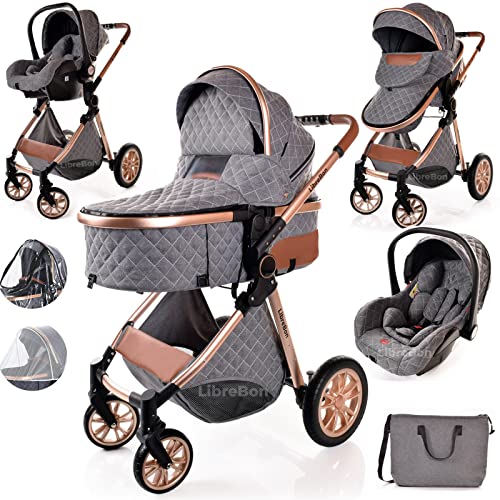The Comprehensive Guide to Choosing the Right Pram for Newborns
The arrival of a newborn brings both immense delight and an array of choices that parents need to browse. One of the important purchases is picking the ideal pram, which not only makes sure the baby's safety however also supplies benefit for moms and dads. This guide intends to provide an extensive check out choosing the suitable pram for newborns, going over different types, functions, safety considerations, and upkeep tips.
Comprehending the Types of Prams
Prams vary commonly in style and performance, which can be overwhelming for new moms and dads. Here's a breakdown of the most typical types of prams readily available in the market:
| Type of Pram | Description | Pros | Cons |
|---|---|---|---|
| Traditional Prams | Created for infants, these prams usually have a deep bassinet. | Comfy for newborns, Safe for sleeping. | Large and heavy, Hard to maneuver in tight spaces. |
| Travel Systems | A mix of a safety seat and a stroller, permitting easy transition in between automobile and stroller. | Flexible and hassle-free, Cost-effective. | May be much heavier than standalone strollers, Not all elements appropriate for newborns. |
| Lightweight Strollers | Compact and easy to maneuver, these are ideal for parents on the go. | Portable and simple to utilize, Generally more inexpensive. | Less cushioning, May not recline fully for newborns. |
| Convertible Strollers | Strollers that can adjust from a carrycot for newborns to a toddler stroller. | Multi-functional and lasting, Adjustable setups. | Can be costly, May need more maintenance. |
| All-Terrain Strollers | Built for rough terrains, these strollers typically include bigger wheels. | Durable for outside use, Stable on different surface areas. | Heavier and bulkier, Can be hard to guide indoors. |
Key Features to Consider
When picking a pram for newborns, several functions can substantially affect use and safety. Here are important functions to bear in mind:
- Safety Harnesses: Look for a pram that includes a five-point security harness to make sure the baby remains safe and secure while in transit.
- Reclining Seat: A completely reclining seat enables newborns to lie flat, which is vital for their spinal column and breathing health.
- Suspension System: A good suspension system provides a smoother trip, vital for the delicate bodies of newborns.
- Brake System: Ensure the pram has a trusted brake system to avoid mishaps. Hand brakes or foot brakes can be efficient alternatives.
- Storage Space: Consider a pram with sufficient storage space for diaper bags, shopping, or other basics.
- Weight and Foldability: Choosing a lightweight alternative that folds easily is vital for benefit, especially for public transport.
Security Considerations
Focusing on safety is paramount when it pertains to prams for newborns. Here are important safety pointers to guarantee the well-being of your baby:
- Check for Stability: Make sure the pram stays stable when fixed. A large base can supply increased stability.
- Avoid Overloading: Only place items recommended by the maker in the storage basket; excess weight can lead to tipping.
- Regular Maintenance: Inspect the wheels, brakes, and harness systems regularly to guarantee they operate appropriately.
- Buckle Up: Always utilize the safety belt, even for quick trips, to avoid the baby from slipping or falling out.
- Expect Age Recommendations: Follow the producer's guidelines concerning weight limits and age recommendations for security.
Upkeep Tips
Taking care of a pram ensures its longevity and safety for your newborn. Here are necessary upkeep suggestions:
- Regular Cleaning: Wipe down the pram frame and wash fabrics according to maker instructions to keep it sanitary.
- Inspect the Wheels: Check wheels for damage and clean them frequently to prevent blocked movement.
- Check Folding Mechanism: Ensure the folding system operates efficiently without sticking or jamming.
- Lubricate Moving Parts: Apply the proper lubricant to moving parts to guarantee quiet and seamless operation.
- Shop Properly: When not in usage, save the pram in a dry area to avoid rust and maintain fabric stability.
Often Asked Questions (FAQs)
1. For how long can Baby Prams Pushchairs be in a pram?
For newborns, it is typically recommended to restrict undisturbed time in a pram to about 1-2 hours to avoid problems with development and blood circulation.
2. Which pram is best for a newborn?
The best pram for a newborn is one that offers a fully flat recline, has an excellent security harness, and meets existing safety standards. Many moms and dads choose travel systems for their adaptability.
3. Can I use a stroller without a car seat for a newborn?
It's recommended to use a stroller with a flat or near-flat recline for newborns. Some strollers are only appropriate from six months and up, so examine the maker's guidance.
4. When should I change from a pram to a stroller?
You can move from a pram to a stroller when your baby can sit up separately, typically around 6 months, but this can vary. It's constantly best to consult the private pram or stroller guidelines.
5. What is the best way to clean my pram?
Constantly describe the maker's directions, however generally, you can clean fabrics with mild soap and water and wipe down tough surfaces with disinfectant wipes.
Picking the right pram for a newborn is a considerable decision that impacts both the baby's convenience and the parent's way of life. By comprehending the kinds of prams offered, key features to consider, security techniques, and upkeep pointers, moms and dads can make informed choices that improve their family's mobility and guarantee the security of their kids. Investing time in research study now pays off in the long run for pleasurable getaways and treasured memories.

